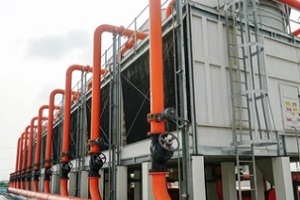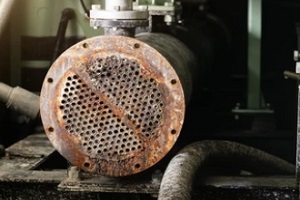Water treatment systems are an important part of many businesses, and it is crucial that these systems are kept in good condition.
Why Cooling Towers Are Essential
 One of the most important parts of an HVAC water system is the cooling tower. Cooling towers play a crucial role in keeping a variety of systems, such as air conditioners and plant cooling systems, running at an efficient and sustainable pace.
One of the most important parts of an HVAC water system is the cooling tower. Cooling towers play a crucial role in keeping a variety of systems, such as air conditioners and plant cooling systems, running at an efficient and sustainable pace.
If the cooling tower is not functioning properly, it can cause a number of problems for your business. Those problems include but are not limited to decreased productivity and higher energy costs.
Maintaining a cooling tower is no easy task, as these machines require a regular maintenance schedule in order to remain functional. Understanding some of the most pressing challenges related to cooling tower maintenance will give you a leg up on enacting best practices for preventive maintenance.
Main Cooling Tower Maintenance Challenges
Repairing and Replacing Aging Parts
One of the main challenges businesses face when it comes to repairing and replacing aging parts. Parts wear out over time, even in the most well-maintained systems. If they are not replaced, it can damage or compromise the entire cooling tower system.
One of the dangers of not replacing worn-out parts in cooling towers is that it can lead to a decrease in efficiency. This can cause the cooling tower to work harder than it should, which can lead to increased energy costs and even breakdowns. Furthermore, subpar or irregular maintenance can lead to the spread of bacteria and other contaminants that are dangerous to public health.
Contaminated water is harmful to both cooling tower employees, who work in close proximity to the towers, as well as cooling tower customers. It can also lead to the spread of Legionella bacteria, which regularly plagues the NYC community in the form of Legionnaires disease outbreaks.
Managing Corrosion and Scaling
 Maintaining a water treatment system can be difficult, particularly in environments with high levels of corrosion and scaling. These factors can reduce the efficiency of the system and cause extensive damage to the equipment. In order to ensure that your business is able to cool towers effectively in 2022, it is important to understand and manage corrosion and scaling properly.
Maintaining a water treatment system can be difficult, particularly in environments with high levels of corrosion and scaling. These factors can reduce the efficiency of the system and cause extensive damage to the equipment. In order to ensure that your business is able to cool towers effectively in 2022, it is important to understand and manage corrosion and scaling properly.
Corrosion can occur when water comes into contact with certain materials, such as steel or copper. This can cause the metal to degrade and eventually fail. Scaling occurs when minerals in the water deposit on surfaces, such as heat exchangers or pipes. This can lead to a decrease in the system’s efficiency and an increase in energy costs.
Fortunately, both corrosion and scaling can be managed through proper water treatment. Treatment methods vary depending on the type of make-up water and the level of corrosion or scaling ions present. However, some common methods include chemical addition, filtration and softening.
It is important to remember that corrosion and scaling are ongoing problems that require regular monitoring. If left unattended or untreated, these problems can cause extensive damage to your water treatment system and increase your operating costs and minimize the efficiency of your cooling tower.
Handling Environmental Regulations
In 2022, changes are expected for the environmental regulations that govern cooling tower maintenance and operations. Businesses should anticipate new challenges when it comes to maintaining their water treatment systems, once stricter regulations are rolled out. If you own a business, you will need to consider how to comply with these new regulations in a cost-effective manner.
The new regulations will require businesses to use specific types of water treatment chemicals and make sure that the water is being recycled properly. Businesses will also need to make sure that their cooling towers are registered with the local health departments.
One of the most important new regulations for cooling towers is the water discharge limit. This limit sets the maximum amount of pollutants that can be released into the environment. Cooling towers must also meet Best Management Practices (BMPs) for controlling discharges.
There are a few ways to meet these environmental regulations:
- The first way is to install an effluent treatment system. This system will treat the water before it is discharged, removing any pollutants.
- Another way is to reduce the number of pollutants in the water. This can be done by installing pollution control devices, such as scrubbers or filters.
- The final way is to recycle the water. This can be done by using a water reuse system or a rainwater harvesting system.
Maintaining Cost Efficiency
In order to keep cost efficiency in check for your 2022 cooling tower operations, it will be critical to focus on streamlining the maintenance process as much as possible. You can accomplish this by implementing strategies such as a regular maintenance and cleaning schedule, appropriate insulation, and ensuring that the tower is properly sized for the facility.
In addition, it will be important to closely monitor energy usage and make changes, as needed, in order to keep costs down.
Keep Your Cooling Tower Efficient and Compliant Throughout 2022
For the best chance at success, reach out to a cooling tower-maintenance expert. These maintenance tasks require a great deal of hands-on experience and knowledge. Working with professionals can save you money as well as invaluable amounts of time, so you can focus on your business operations instead.
By implementing a comprehensive water treatment plan, however, you can keep your system running smoothly and effectively in 2022. For more information, reach out to our team of experts today at 212-518-6475.
